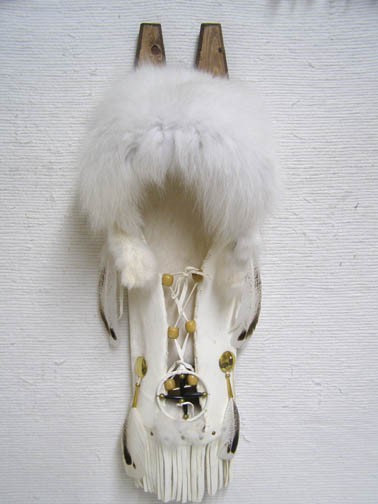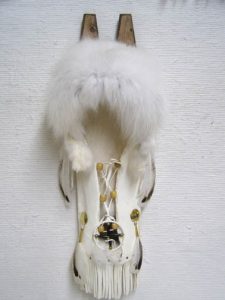
While swaddling and baby carrying seem like the latest ideas in parenting trends, these soothing practices have been an important part of childrearing traditions in the Native American culture for thousands of years. Variations of the Native American baby carrier are found across hundreds of North American tribes, including the Shoshone, Cree, Ojibwe, Winnebago, Nez Perce, Iroquois, Navajo and Hopi communities.
 Like other babywearing customs around the world, use of cradleboards has declined over the last century. However, modern parents are reviving the ancient practice as a way to soothe, protect and engage with their young children. Infants are wrapped tightly in a blanket and then strapped to a board with bindings. Other defining features of the Native American baby carrier include the footrest, which allows the board to stand upright, and a wooden hoop to protect the baby’s head. Leather straps are attached so that the cradle can be worn like a backpack, but it is also useful as a feeding chair and sleeper.
Like other babywearing customs around the world, use of cradleboards has declined over the last century. However, modern parents are reviving the ancient practice as a way to soothe, protect and engage with their young children. Infants are wrapped tightly in a blanket and then strapped to a board with bindings. Other defining features of the Native American baby carrier include the footrest, which allows the board to stand upright, and a wooden hoop to protect the baby’s head. Leather straps are attached so that the cradle can be worn like a backpack, but it is also useful as a feeding chair and sleeper.
The versatile cradleboard is not only used to safely secure and carry babies but also to bless and nurture them as they grow. The calming swaddling technique restricts arm and leg movement, which mimics the comforting environment of the womb. The physical closeness allows mother and child to tune into the rhythms of each other’s heartbeats and breathing, which also has a calming effect. The rigid support promotes a straight back while the constant movement helps them quickly learn to control their balance and the stimulation encourages active learning.
Physical Blessings and Spiritual Protections
Many native communities hold cradleboard ceremonies in the days following a baby’s birth. Traditions vary widely among tribes, but families typically gather to offer prayers, blessings and amulets as the baby is placed into the carrier for the first time. Comanche babies are smudged with cedar smoke while pollen is placed on the eyes and noses of Apache infants.
If an heirloom cradle is not available to use, then new fathers or elder artists in the community take on the sacred duty of building the cradle. Careful attention is given to the construction not only for the safety of the baby but also to bestow spiritual protections and physical blessings. As materials are gathered, prayers are recited to bless the child with health and a long life.
Each handmade cradle is unique, often taking months to complete, and the design and materials are influenced by regional materials. Wood planks are most common although some tribes prefer woven fiber baskets. The Crow favor a single, round headboard while the Lakota use two long slats to represent the duality of life. The Navajo cradleboard is traditionally made from the eastern side of white pine or cedar, and a tree that has been struck by lightning is considered especially auspicious. The board is richly decorated with intricate carvings or paintings to depict powerful animals, ancestral symbols or tribal emblems.
Along with offering physical protection, the hoop encircling the head also serves as a carry handle and a place to hang sacred objects. Parents can attach tanned leather to form a shade canopy or herbal sachets to offer protection from the elements. Dangling good luck charms, such as dreamcatchers, medicine wheels and beaded amulets that hold the umbilical cord, are also common. Other traditions include hanging animal teeth, claws, shells, feathers or reed circles.
Traditionally, the bedding was made from the tanned skin of buffalo, deer or elk and padded with moss to cushion the stiff boards. Modern families typically wrap babies in thin muslin or cozy cotton blankets with an outer layer of leather or a thicker blanket. In colder climates, fox or coyote fur is used as a lining and around the head to keep the baby warm. Like the board, the cloth may be adorned with colorful beads, fringes or decorative prints. The crisscross design of the leather bindings also carries spiritual blessings for the child to be able to bear their own children one day.
Kachina House carries an authentic selection of Navajo and Cherokee cradleboards that are sure to become heirlooms in your own family.


thank you so much for the information. Beautiful items.